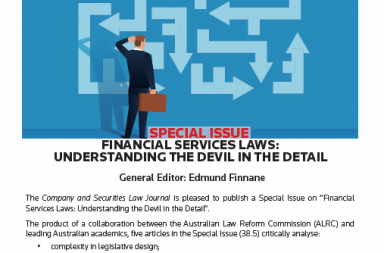*Please note that the links to the content in this Part will direct you to Westlaw AU.
To purchase an article, please email: [email protected] or contact us on 1300 304 195 (Australian customers) or +61 2 8587 7980 (international customers) during business hours (Mon-Fri, 8am-6pm AST).
The latest issue of The Tort Law Review (Volume 28 Part 2) contains the following material:
Articles
High-profile defamation proceedings in Australia (Voller) and New Zealand (Wishart) have sought to hold Facebook Page operators liable for third parties’ comments. Relevant to this issue are relatively under-scrutinised, legislative “safe harbours†from liability available to “content hosts†– and capable of covering a wide range of online intermediaries. Given appellate decisions in both proceedings, this article considers each safe harbour’s potential effects on defamation liability arising from publication (subject to innocent dissemination), to assess their prospective impact. It is argued that the combined effect in each jurisdiction risks treating online intermediaries too monolithically and fails to set out a clear path to addressing difficulties with the traditional common law approach to publication coupled with innocent dissemination. The pending judgment of the High Court in Voller as well as defamation law reform processes (specifically the Stage 2 review of Australia’s Model Defamation Provisions) present opportunities to change this balance.
Click here to access article on New Westlaw
One More Chance for Loss of Chance? Re-examining Loss of Chance through the Lens of Actionable Damage – Louis Lau Yi Hang
The loss of chance doctrine has proven to be a conundrum within the field of negligence. While some view it as an exception to causation, others believe that a more appropriate inquiry turns on the question of actionable damage. This article argues that adopting the former approach unduly distorts traditional understanding of causation principles and its exceptions. Rather, the latter approach is preferred, and is supported by judicial precedents across various common law jurisdictions. Specifically, it is argued that the basis of actionable damage lies in the protection of personal interests, and policy reasons can be canvassed to support its recognition. On this view, not only are there cogent policy reasons supporting the recognition of loss of chance as a new head of damage to protect the interests of patients, such a framework also prevents the employment of policy reasons from being criticised as akin to an “unruly horseâ€.
Click here to access article on New Westlaw
Reel Harm: Negligence Liability for Psychiatric Harm Sustained by Reality Television Contestants – Tina Popa and James Gilchrist Stewart
The advent of reality television programs, such as cooking competitions, matchmaking, and adventure programs, has seen an increase in adverse effects on reality television contestants’ mental health, including psychiatric conditions, bullying, online trolling, and suicides in extreme cases. This article shines a spotlight on this emerging legal issue by exploring the possible avenues for reality television contestants to claim compensation for mental harm. The article discusses Prince v Seven Network (Operations) Ltd and Green v Seven Network (Operations) Ltd, and the impact these decisions are likely to have. Through a Victorian lens, the authors explore compensation avenues under statutory schemes, common law claims, breach of statutory duty and contractual issues. The authors contend that no-fault statutory compensation schemes (where contestants are characterised as workers) are the most appropriate avenue for compensation, to ensure that psychologically fragile contestants are spared protracted litigation proceedings.
Click here to access article on New Westlaw
Developing a Contextual-pluralist Model of Vicarious Liability – James Brown
This article presents a somewhat novel way of looking at vicarious liability by developing a model that is both sensitive to context and factual nuance, and understanding of the fact that none of the purported theoretical justifications for the doctrine are entirely satisfactory on their own. It is suggested that a pluralistic balancing approach to the relevant theories could be predicated on the somewhat recent emergence of the “fair, just and reasonable†test in this area of law. From a normative standpoint, this is likely to lead to a more meaningful, adaptable and transparent law on employer liability. The article also highlights that the adoption of a contextual-pluralist model may lead to a more consistent and in-depth judicial application of the various rationales for vicarious liability. In so doing, it claims that judges should adopt a so-called “thick approach†to the use of theory.
Click here to access article on New Westlaw
For the PDF version of the table of contents, click here: Westlaw AU – Tort L Rev Vol 28 No 2 Contents or here: New Westlaw AU – Tort L Rev Vol 28 No 2 Contents.
Click here to access this Part on Westlaw AU
Click here to access this Part on New Westlaw AU
For general queries, please contact: [email protected].


